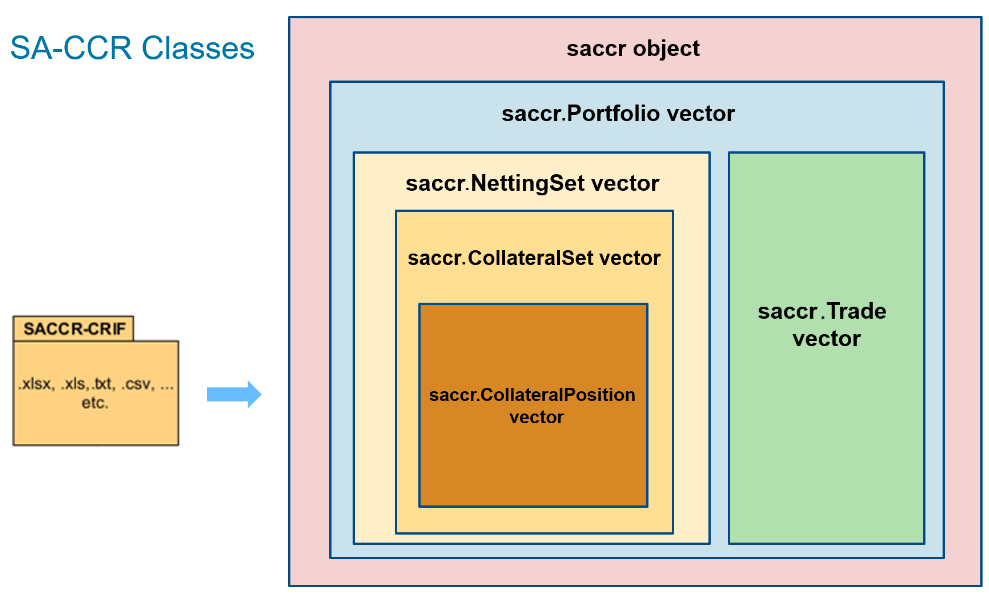saccr
Description
Create a saccr object using this workflow:
Create a SA-CCR CRIF file.
The ISDA® SA-CCR Common Risk Interchange Format (CRIF) is a standardized format developed by the International Swaps and Derivatives Association (ISDA) for reporting counterparty credit risk exposures under the Standardized Approach for Counterparty Credit Risk (SA-CCR) framework. For more information on creating an ISDA SA-CCR CRIF file, see ISDA SA-CCR CRIF File Specifications. SA-CCR functionality meets ISDA benchmarks for use in the
saccrobject.Create a
saccrobjectUse
saccrto create asaccrobject. The following objects are contained in thesaccrobject:Portfolio,NettingSet,CollateralSet,CollateralPosition, andTrade. For more information, see saccr Object Structure and SA-CCR Transactional Elements.Use
saccrobject functions.Use the following functions to calculate replacement cost (RC), add-ons, potential future exposure (PFE), and exposure at default (EAD):
Aggregate EADs.
After using
addOnandead, you can useaggregateto aggregate add-ons over all asset classes or EADs over all portfolios.After using
ead, you can use theaggregateByCounterpartyto aggregate EADs by counterparty.
For more information on this workflow and a list of examples, see SA-CCR Transactional Elements and Framework for Standardized Approach to Calculating Counterparty Credit Risk: Introduction.
Creation
Description
mySACCR = saccr(SACCRCRIF)saccr object and sets the properties. The
saccr object provides an object-based framework that
supports Basel-compliant, International Swaps and Derivatives Association
(ISDA) workflows for calculating the capital banks must hold to
cover the risk that a derivative's trading partner will fail to pay its
obligation.
mySACCR = saccr(___,Name=Value)mySACCR =
saccr("SACCR_CRIF.xlsx",Alpha=1.3,DomesticCurrency="EUR",MaturityBusinessDaysFloor=7,NumBusinessDaysYear=255)
creates a saccr object. You can specify multiple
name-value arguments.
Input Arguments
Properties
Object Functions
Examples
More About
References
[1] Bank for International Settlements. "CRE52 - Standardised Approach to Counterparty Credit Risk." June 2020. Available at: https://www.bis.org/basel_framework/chapter/CRE/52.htm.
[2] Bank for International Settlements. "CRE51 - Counterparty Credit Risk Overview." January 2022. Available at: https://www.bis.org/basel_framework/chapter/CRE/51.htm.
[3] Bank for International Settlements. "CRE22- Standardised Approach: Credit Risk Migration." November 2020. Available at: https://www.bis.org/basel_framework/chapter/CRE/22.htm.
[4] Bank for International Settlements. "Basel Committee on Banking Supervision: The Standardised Approach for Measuring Counterparty Credit Risk Exposures." April 2014. Available at: https://www.bis.org/publ/bcbs279.pdf.
Version History
Introduced in R2024a
See Also
Functions
Topics
- Framework for Standardized Approach to Calculating Counterparty Credit Risk: Introduction
- Create saccr Object and Compute Regulatory Values for Interest-Rate Swap
- Create saccr Object and Compute Regulatory Values for Forward FX Swap
- Create saccr Object and Compute Regulatory Values for Two CDS Trades
- Create saccr Object and Compute Regulatory Values for Multiple Asset Classes
- Create saccr Object and Compute Regulatory Values for Multiple Asset Classes with Netting Set
- Create saccr Object and Compute Regulatory Values for Multiple Asset Classes with Netting Set and Collateral Set
- Create saccr Object and Compute Regulatory Values for Multiple Asset Classes with Netting Set, Collateral Set, and Collateral Positions
- Create saccr Object and Compute Regulatory Values for Multiple Portfolios Containing Multiple Asset Classes
- SA-CCR Transactional Elements
- ISDA SA-CCR CRIF File Specifications

